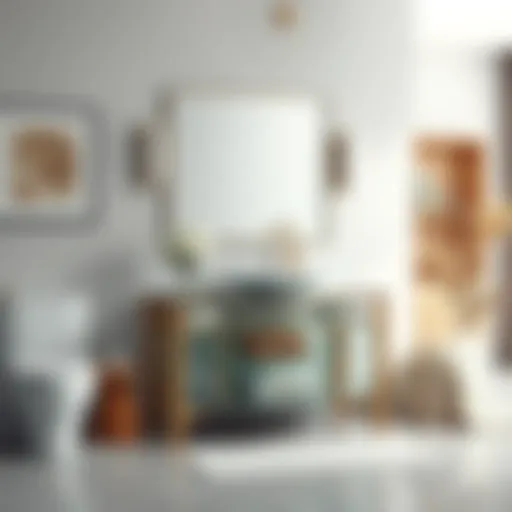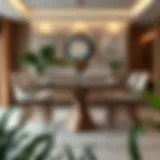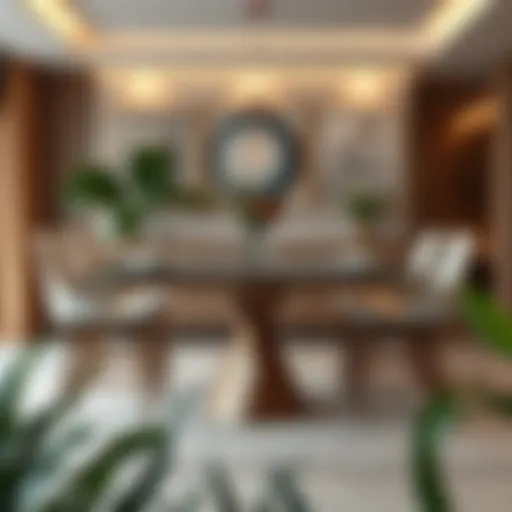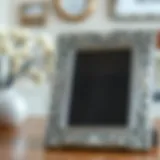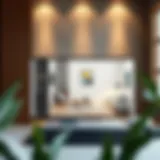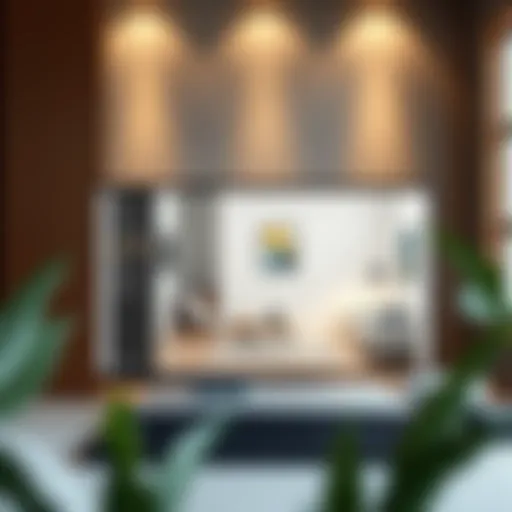Exploring Virtual Kitchen Design Apps for Modern Spaces


Intro
As we leap into the realm of cooking, the kitchen emerges as more than just a place for culinary creations; it transforms into a canvas for design and innovation. With technology advancing faster than a chef’s knife slicing through onions, virtual kitchen design applications have become a beacon for homeowners and designers alike. These tools allow users to visualize and manipulate their spaces without lifting a hammer or breaking into a tile store. From aesthetically pleasing layouts to functional storage solutions, the possibilities unfold with just a few clicks.
Understanding how these applications fit into the bigger picture of home design is crucial. Not only do they facilitate creativity, but they also cater to the practical needs of modern living. By examining the core features and unique advantages of these tools, we aim to uncover their impact on the home design process. Moreover, we aim to discuss the challenges and considerations that users must keep in mind when embarking on their virtual design journey.
Buckle up, as we venture deeper into this exciting topic of virtual kitchen design, where the digital meets the domestic, and your imagination can run wild.
Understanding Virtual Kitchen Design Apps
The landscape of kitchen design has transformed significantly with the advent of technology, paving the way for virtual kitchen design apps. These platforms represent not just a trend, but a fundamental shift in how we envision and create our culinary spaces. It’s crucial to comprehend the backbone of these applications as they bring together creativity and practicality, allowing users—from budding chefs to seasoned designers—to engage with their environment in profound ways.
The importance of understanding virtual kitchen design apps lies in their potential to revolutionize the design process. These tools empower users with the ability to visualize kitchen layouts, which can sometimes feel a touch overwhelming at the start. They aid in transcending the limitations of traditional design methods, which often can feel restrictive and less interactive.
Definition and Overview
Virtual kitchen design apps provide a digital environment for users to create and manipulate kitchen layouts. These applications typically offer an intuitive interface that allows for drag-and-drop features, where homeowners can position cabinets, appliances, and accessories. The appeal of such apps is their ability to offer a simulated experience of seeing how elements work together without hassle.
At their core, these applications make it possible to dream up spaces that are not just functional but aesthetically pleasing. Users can experiment with different styles, colors, and configurations—all on-screen. This ease of manipulation allows individuals to gain confidence in their design choices. In our busy lives, having a tool that helps visualize the end product can make real-life decisions smoother.
History of Kitchen Design Apps
The journey of kitchen design apps is an interesting one, evolving in tandem with advances in technology. The inception of digital design tools can be traced back to basic computer-aided design (CAD) programs, which primarily catered to professionals in the architecture and interior design industries.
As technology evolved and personal computing became ubiquitous, the market saw the rise of more specialized software catering specifically to kitchen design. The early 2000s marked a pivotal turn when companies began to recognize the potential for consumer engagement in home design. A landmark moment was the introduction of user-friendly programs, reducing the steep learning curve associated with CAD software. Some early adopters of these platforms showed how a seamless interface could empower all sorts of users to embark on projects without needing advanced design skills.
Over the years, the interface of these applications has continued to evolve significantly. The integration of more realistic 3D imaging and augmented reality features transformed the way users interact with their designs. This evolution is not simply a technological marvel; it reveals a growing understanding of the needs and preferences of everyday users. By learning from experiences and feedback, developers iterated their products to create solutions that indeed resonate with aspiring home designers.
As virtual kitchen design apps continue to develop, the historical context underscores their role in democratizing design. They encourage creativity regardless of background or experience. With this knowledge established, it opens the door to deeper discussions on the key features, benefits, and the implications these applications bring to modern-day kitchen design.
Key Features of Virtual Kitchen Design Apps
Virtual kitchen design apps are at the forefront of modern interior design, significantly influencing how homeowners and designers approach kitchen renovations. These tools bridge the gap between creativity and practicality, offering a suite of features designed to streamline the design process. Understanding the key features of these applications is essential for anyone looking to enhance their culinary spaces effectively.
User-Friendly Interfaces
One of the standout elements of virtual kitchen design apps is their user-friendly interfaces. A clear and intuitive layout allows users—whether seasoned designers or novices—to navigate through tools without feeling lost or overwhelmed. For instance, most apps adopt drag-and-drop functionality, which means you can easily place cabinets, appliances, and other elements exactly where you envision them. This simplicity invites engagement; users often find themselves excited to experiment with different layouts and designs.
In addition, many apps offer tutorials and support features, easing the learning process. These resources are invaluable for those who may not be tech-savvy but still want to explore kitchen design.
3D Visualization Capabilities
3D visualization capabilities are a game changer. They allow users to see their designs from all angles, offering a realistic preview of what the final product will look like. Instead of relying on 2D sketches, users can walk through their kitchens virtually before any physical changes are made. This aspect not only helps mitigate unwelcome surprises but also ignites creativity. The ability to rotate and zoom in provides greater detail than ever before, enabling users to make well-informed choices about colors, textures, and arrangements.
Furthermore, the stunning visuals help users communicate their ideas more effectively with professionals. A picture’s worth a thousand words, and in this case, being able to share 3D renderings allows for clearer discussions about tweaks and adjustments.
Customization Options
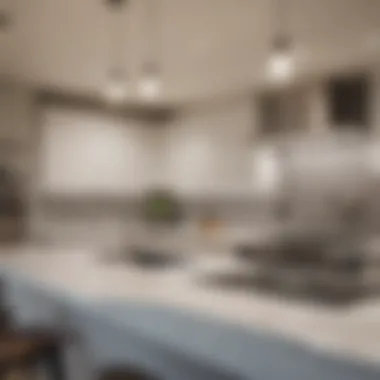

Customization is another cornerstone of these applications. Every kitchen is unique, rooted in personal style and functional needs. Thus, apps offer extensive customization options to suit individual preferences. Users can tailor cabinets, countertops, backsplashes, and even flooring materials to match their vision. This flexibility encourages experimentation, where users may mix and match styles until they find the perfect balance that resonates with their tastes.
Some apps even allow users to upload photos of materials they are considering, making the choices more personal and grounded in reality. This feature not only streamlines decision-making but also enhances satisfaction throughout the design process.
Integration with Augmented Reality
The integration of augmented reality (AR) represents the next leap in virtual kitchen design. By utilizing a smartphone camera, users can project their designs directly into their existing kitchen space. This feature provides a remarkable perspective, allowing users to visualize the scale and fit of their planned design in real-time. It makes a world of difference when deciding whether a large island complements the kitchen layout or if a specific color scheme harmonizes with other elements.
AR also bridges the gap between digital design and physical reality, offering a tangible sense of how the new kitchen will work in conjunction with the home’s overall flow.
"Seeing your design in situ takes the guesswork out of planning, giving a clearer view of how it will actually come together."
In summary, the key features of virtual kitchen design apps—user-friendly interfaces, 3D visualization, customization options, and integration with augmented reality—are pivotal to transforming culinary spaces. They empower users, enhance visualization, and streamline the design process, ultimately elevating the experience for homeowners, designers, and anyone interested in creating a functional and beautiful kitchen.
Benefits of Using Virtual Kitchen Design Apps
With the surge in technology's role in our daily lives, virtual kitchen design apps have landed firmly on the culinary stage, providing various advantages that are hard to overlook. In this section, we will explore the significant benefits these applications offer, particularly how they enhance visualization, streamline planning, and foster collaboration among users. These tools are not just a trend; they are carving paths to smarter designs and improved experiences in kitchen renovations and creations.
Enhanced Visualization for Planning
The power of visualization cannot be overstated, especially when it comes to kitchen design. Traditional methods often leave homeowners guessing how different elements will mesh together. Virtual kitchen design apps bridge that gap quite effectively. They offer tools that can bring a user’s vision to life with just a few taps on their devices.
Imagine being able to see various cabinet styles, countertops, and colors all in one space. This capability allows users to visualize design choices before making any financial commitment. With high-quality 3D renderings, it’s almost like being in a virtual showroom where one can mix and warp ideas effortlessly.
"Seeing is believing, and in the world of design, this rings especially true."
Homeowners can experiment with layouts that offer practical utility and aesthetic appeal. Want an island in the center or an L-shape setup against a wall? Just drag and drop to experiment. It is simple, intuitive, and gives the assurance that the final design will meet both functionality and style preferences.
Time and Cost Efficiency
Time is money, as the saying goes, and when you’re knee-deep in kitchen renovations, you want to save both. Virtual kitchen design apps can be a game changer in this respect. Through efficient planning and design, they help minimize missteps, which often lead to costly renovations. Nobody wants to shell out extra bucks for a mistake that could have been easily avoided.
With these apps, users can develop a comprehensive plan with a clear budget. Most applications have built-in calculators that can help users get a realistic idea of how much different elements are going to cost. This proactive approach ensures that one can prioritize spending on items that matter most.
- Reduced Planning Time: Users can create designs in a fraction of the time it would take to sketch or manually layout ideas.
- Cost-Saving Features: The ability to visualize changes reduces the likelihood of erroneous purchases or modifications later on.
- Stress Reduction: Knowing that you have a solid plan cuts down on anxiety.
Improved Collaboration with Designers
The days of back-and-forth communication via sketches and spreadsheets are fading fast. Virtual kitchen design apps foster collaboration by offering shared spaces where homeowners and designers can brainstorm. This functionality allows parties to have a common ground, making exchanges easier and more productive.
Imagine sitting down with a designer over a cup of coffee, both staring at the same virtual layout. Changes can be made instantly, allowing for immediate feedback. This kind of cooperation does not just streamline the process; it cultivates a more engaging experience where creativity blossoms and ideas bounce off each other.
In addition, many of these apps allow real-time commenting on designs, so every suggestion and amendment is noted without losing track of the original vision. This is invaluable in creating a space that truly reflects the user's needs.
If you're a DIYer or a professional designer, this interactive approach improves transparency and leads to more tailored results in the final kitchen product.
In essence, virtual kitchen design applications are influencing more than just aesthetics; they’re changing the entire paradigm of planning and executing one of the most cherished spaces in any home.
Challenges and Limitations
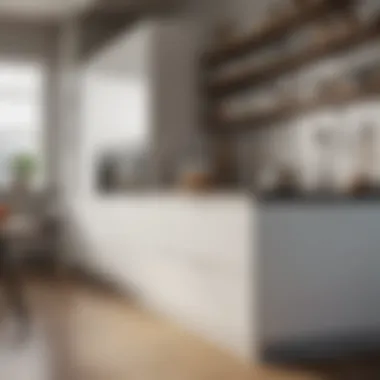

When delving into the world of virtual kitchen design apps, it's vital to acknowledge the challenges and limitations that accompany these innovative tools. As much as they open doors to creative possibilities and streamline design processes, hurdles still exist that can impact the user experience and overall effectiveness of these applications. Understanding these limitations can guide homeowners, designers, and DIY enthusiasts in utilizing these tools more effectively.
Technology Accessibility Issues
One of the most significant constraints is the accessibility of technology itself. While the concept of virtual kitchen design apps is exciting, not everyone has equal access to the necessary tools. Many apps require robust hardware and internet connectivity, leading to a digital divide where some users might find themselves on the outside looking in.
Those in rural areas, or people who may not have the latest smartphones or tablets, might struggle to use these applications effectively. For instance, a family living in a small town might want to redesign their kitchen but lack the required computing power to run a sophisticated app that provides rich 3D visualizations. This poses a problem, as poorer access to technology can mean that the very advantages of design innovation remain out of reach for many.
Learning Curve for Users
Another challenge is the learning curve associated with these apps. Even though some virtual kitchen design tools tout user-friendliness as a selling point, that does not guarantee instant mastery for every user. As seasoned designers often know, one person’s intuitive interface can be another's nightmare.
For instance, a homeowner unfamiliar with design software might feel overwhelmed by a plethora of options, features, and tools. Initially, this could lead to frustration rather than inspiration. Many users may find it easier to sketch ideas on paper instead of diving into a complex app, which often diminishes the value these tools can provide. Providing tutorials and customer support can help, but there remains an inherent barrier that can deter potential users from fully embracing the digital design experience.
Potential Design Over-Reliance
Finally, we must consider the risk of over-reliance on these virtual design tools. While they offer exciting insights and visualizations, they can also lead individuals to lean too heavily on them, potentially stifling creativity and critical thinking in the design process.
For instance, relying solely on an app's algorithmic suggestions may lead to cookie-cutter designs that lack personalization and distinctiveness.
It’s essential for users to remember the importance of engaging with the space itself rather than just what appears on the screen. Balancing technological assistance with traditional design sensibilities is crucial, or one might end up with a kitchen that feels more like a simulation than a homey spot for culinary exploration.
In summary, while virtual kitchen design apps usher in a new era of design flexibility and creativity, they also come with challenges that can hinder their full potential. Recognizing these hurdles helps in crafting a more holistic approach to kitchen design that combines digital innovation with real-world practicality.
Popular Virtual Kitchen Design Apps
Understanding the significance of Popular Virtual Kitchen Design Apps is key to harnessing their potential in today’s culinary world. These applications are more than just a digital means to visualize your kitchen—they represent a bridge between aspiration and reality. Users can explore layout options, experiment with styles, and make informed decisions before lifting a hammer or paintbrush. In an age where personalization is paramount, these tools empower individuals to curate spaces that reflect their character and needs.
Overview of Top Applications
When diving into the world of virtual kitchen design apps, we encounter a variety of user-friendly platforms tailored to all types of consumers—from rookie DIYers to seasoned designers. Here’s a closer look at some of the top applications that have hit the market:
- SketchUp: A perennial favorite among designers, SketchUp offers sophisticated modeling tools while maintaining ease of use. It’s especially handy for those looking to transition their designs from virtual to real life.
- IKEA Kitchen Planner: This tool isn't just for those loyal to IKEA. Its interactive interface allows users to create realistic layouts with IKEA products, providing a tangible sense of scale and function.
- Planner 5D: Renowned for its intuitive interface, Planner 5D enables users to switch between 2D and 3D views seamlessly. It’s an ideal platform for those who enjoy visualizing their space from multiple angles.
- Home Design 3D: This app caters to those who want a comprehensive design experience. It allows modifications in real-time, making it easier to see how changes affect the overall design.
- Roomstyler 3D: This platform is great for those who want to focus on aesthetics rather than just layout. It offers an extensive library of furniture, allowing users to style their kitchens with various elements.
Each of these applications brings unique strengths, enabling users to tailor their culinary spaces according to personal taste and functional needs. Choosing the right app often comes down to specific requirements, preferences, and desired outcomes.
Comparative Analysis
Examining these popular virtual kitchen design apps reveals not just their individual features but also the ways in which they complement or compete against each other. Here are some considerations:
- User Experience: Applications like IKEA Kitchen Planner prioritize simplicity, making them ideal for those who may not be tech-savvy. In contrast, SketchUp may have a steeper learning curve, yet it rewards users with greater versatility.
- Customization Options: While Planner 5D excels in allowing a wide range of adjustments and ideas to come to life, others like Home Design 3D offer less freedom but often come with faster execution times.
- Cost: Some apps are free with basic features but require subscriptions for premium options. Understanding the total cost of ownership is critical. For example, designers may find significant value in investing in a robust tool like SketchUp as their needs grow.
- Integration Capabilities: Not all apps can seamlessly connect with other home design software. This can be a deciding factor for users looking for holistic solutions that are easy to stack with other digital tools.
Impact on Modern Kitchen Design
The emergence of virtual kitchen design apps has significantly altered the landscape of modern kitchen design. They serve as a bridge between creativity and practicality, allowing both professionals and amateurs to envision their dream culinary spaces in a vivid, interactive manner. With real-time customization and 3D visualization, these tools empower homeowners to explore various layouts, materials, and colors, ensuring that aesthetic preferences meet functional needs. Ultimately, the impact of these applications goes beyond mere aesthetics; they foster a deeper understanding of spatial dynamics and enhance user engagement in the design process.
Trends Shaped by Technology
Technological advancements have played a pivotal role in reshaping kitchen design. One major trend is the increasing prevalence of smart kitchens. As appliances become more interconnected through the Internet of Things, virtual kitchen design apps are also adapting. Users can now incorporate these smart features into their layouts. Imagine designing a kitchen where the refrigerator suggests recipes based on available ingredients or where lighting adjusts automatically to set the mood for different activities.
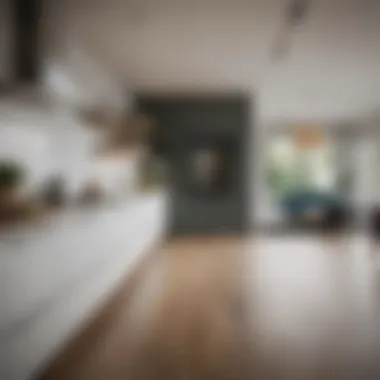

Moreover, sustainable materials have gained traction. These apps enable users to explore eco-friendly options easily. Homeowners can visualize how bamboo cabinetry or recycled glass countertops fit into their designs, allowing for informed decisions that resonate with modern ethical standards. Not to mention the trend of open-concept spaces and multifunctional layouts, which are easier to experiment with when users can see their ideas come to life in real-time.
- Increased demand for smart kitchen solutions
- Eco-friendly materials becoming a design staple
- Open-concept layouts gaining popularity
Case Studies of Successful Renovations
To illustrate the transformative power of virtual kitchen design apps, let's delve into a couple of impactful case studies.
The Johnson Family Kitchen: The Johnsons wanted a space that balanced modern style with practical functionality. Using a popular design app, they experimented with various layouts, finally deciding on a U-shaped design that maximized counter space. The app allowed them to visualize a high-tech double oven and a smart fridge, radically changing their cooking experience. The final result was a showpiece kitchen that won a design award, showcasing the effectiveness of combining technology with traditional design.
Café Delights: A small café located in an urban neighborhood wanted to revamp its kitchen while minimizing downtime. The owner used a virtual kitchen design tool to create a layout that optimized workflow. By simulating various setups, they landed on a design that streamlined operations, reducing the time staff spent moving between stations. This renovation led to improved staff efficiency and a noticeable increase in customer satisfaction. It's a perfect testament to how technology can facilitate seamless operations while enhancing the culinary experience.
"Using virtual design tools turned my kitchen project from a daunting task into an exciting adventure!" - Johnson Family
In summary, the impact of virtual kitchen design apps is profound, offering new pathways for creativity and problem-solving within the sphere of modern kitchen design. They help foster collaboration, inspire innovation, and ultimately improve the overall functionality and aesthetic appeal of culinary environments.
The Future of Virtual Kitchen Design
As technology continues to evolve at a breakneck pace, the realm of virtual kitchen design is no exception. Understanding the future of this field holds critical importance for anyone involved in kitchen renovations—this means homeowners, designers, retailers, DIYers, and students too. The ability to visualize a project before actual implementation is unparalleled and non-negotiable in today's fast-paced world. New innovations in design applications are acting as the catalysts that are reshaping culinary spaces, allowing for unprecedented customization that caters to both functionality and aesthetics.
Emerging Technologies and Innovations
The digital landscape is witnessing a slew of emerging technologies that have the potential to revolutionize virtual kitchen design. Notably, advancements in machine learning and artificial intelligence are enabling apps to predict design preferences based on user interaction. Imagine a scenario where you start a new design, and the app suggests layouts and color schemes based on your prior choices and trending styles. This level of personalized assistance not only simplifies the design process but also injects a layer of interactivity that was previously lacking.
Another significant innovation is the introduction of virtual reality, making the experience of kitchen design feel almost real. Rather than simply viewing a 3D model on a screen, homeowners can step into their prospective kitchens using VR headsets. This immersive experience provides a unique opportunity to test out different lighting schemes, cabinet configurations, and color palettes. It's akin to trying on clothes at a shop before making a purchase, but in the realm of home design, this experience translates into higher satisfaction rates and fewer revisions.
"Virtual reality isn't just a gimmick in design; it’s becoming a requirement for understanding spatial dynamics."
Furthermore, cloud technology plays a vital role in allowing seamless sync between devices. Nowadays, users might start their design on a tablet and continue on a laptop without losing any changes. This bolsters collaborative efforts among designers and clients too, making real-time adjustments a possibility. With apps rolling out updates on-the-fly, staying current with trends becomes significantly easier.
Predictions for User Experience
It’s reasonable to project that user experience will be more tailored than ever in virtual kitchen design apps. Customization is the name of the game. Future iterations will likely incorporate adaptive design algorithms that learn and evolve with the user. As more data is collected, these apps will refine their user interfaces, making them even more intuitive without being cluttered.
Moreover, mobile optimization will likely continue its ascent, enabling users to design kitchens while on the go. Imagine drafting a layout while waiting at the bus stop or reviewing color swatches from the comfort of a café—convenience will be at the forefront.
As technology will inevitably grow more sophisticated, so too will users’ expectations. Features like voice control and gesture recognition could one day render the need for traditional touch inputs obsolete. Users might speak their design wishes or even wave a hand to navigate through various options.
In a nutshell, the future of virtual kitchen design appears brighter than ever. With emerging technologies paving the way for more innovative, user-focused solutions, those in the industry should brace themselves for significant shifts. The ability to customize, visualize, and adapt designs in real-time means kitchen spaces will not just evolve, but flourish—meeting and exceeding the needs of modern users.
Culmination
Virtual kitchen design apps have become more than just a digital tool; they represent a shift in how we conceptualize and create culinary spaces. Their relevance in today’s design landscape cannot be overstated, as they effectively bridge imagination and practicality. One of the standout elements of these applications is their ability to simulate real-life environments, offering users a realistic preview of their kitchen designs before any physical changes are made. This reduces the guesswork that often accompanies interior design, leading to more confident decision-making.
Summary of Insights
Throughout the exploration of virtual kitchen design apps, several key insights have emerged:
- User Engagement: These applications encourage users to actively participate in the design process, tailoring spaces to their unique tastes and lifestyles.
- Visual Planning: With features like 3D visualization, designers and homeowners alike can see their ideas materialize, making adjustments in real-time based on visual feedback.
- Streamlined Collaboration: When working with designers, these apps facilitate easier communication and understanding, as all parties can visualize concepts without ambiguity.
The significance of these findings is profound; they underscore the move towards a more interactive and user-centric approach in interior design.
Final Thoughts on Adoption
As we look to the future, the adoption of virtual kitchen design apps seems inevitable. There are numerous benefits that make these tools appealing; for instance, they not only save time and money but also enhance creativity by allowing users to explore diverse design options. Some may still have reservations about relying on technology for design choices; however, using these apps does not replace the role of skilled designers. Instead, they empower both homeowners and professionals, offering a collaborative space where ideas can flourish.

